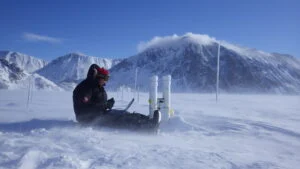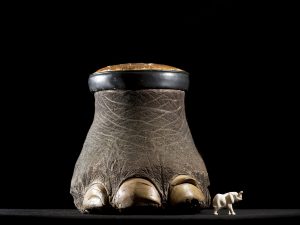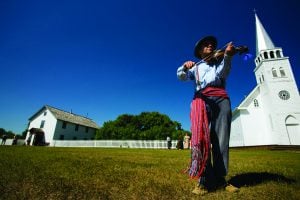
Science & Tech
20 Canadian innovations you should know about
Celebrating Canadian Innovation Week 2023 by spotlighting the people and organizations designing a better future
- 3327 words
- 14 minutes
People & Culture
Marie-Claude Élie was awarded a Canadian Decoration for Bravery after bringing medical assistance to dozens of people trapped beneath the ruins of a collapsed schoolhouse in Port-au-Prince, Haiti on Nov. 7, 2008

On July 20, 1972, the first Canadian Decoration for Bravery was awarded. On the 50th anniversary of the decorations, Canadian Geographic interviews five recipients who have been honoured for their exceptional acts of selflessness. The series forms part of Commemorate Canada, a Canadian Heritage program to highlight significant Canadian anniversaries. It gives Canadian Geographic a chance to look at these points of history with a sometimes celebratory, sometimes critical, eye.
The school collapsed on Nov. 7, 2008 — Marie-Claude Élie’s last day in Haiti. The Red Cross nurse from Laval, Que., had just finished a month-long stint in Port-au-Prince. She was relaxing at her Port-au-Prince hotel, listening to Luc Merville on her ear pods beside the rooftop pool, when she saw the plume of dust rise from the fallen school. She checked her watch. It was 9:30 a.m. on a Friday and Élie knew the school would be full of students.
Élie quickly changed out of her pool clothes and into her Red Cross t-shirt, pulled on her rubber boots and called the Red Cross headquarters for a ride to the disaster site. “I wanted to do something,” she said. “I cannot stay at the hotel resting when there’s something like that going on.”
On their way from the hotel to the school, Élie and two colleagues stopped to load their truck with bottled water to distribute to the victims and rescuers. But their route to the disaster site itself was blocked by the crowds of Haitians who’d filled the streets. “People were panicking,” Élie said. “There were people running all over the place. Screaming ‘My kids, my kids.’ It was messy, messy, messy.”
Élie grabbed her medical kit, left the jeep and ran to the school on foot, leaving the water behind.
The school’s second floor had collapsed, crushing students and teachers on the first floor and in the school’s basement. Élie rushed directly to the stairs to the basement. She knew rescuing survivors from the lowest level should take priority. Élie remembers passing through a room filled with children’s shoes, still neatly lined up in pairs and belonging to the children trapped inside.

Almost immediately, Élie found a 10-year-old girl, her legs crushed beneath two heavy steel girders. “She was screaming,” Élie said. “It was painful, for sure. I didn’t want her to go into shock.” Élie couldn’t tell if the girl had severed an artery in her leg, but she connected an IV to her bag just in case. “She was so courageous,” Élie said. “She was helping me and holding the IV. When a crew of Brazilian rescuers came in to try and free the girl from the rubble, Élie left her so she could help others. “She didn’t want me to go. She said ‘Please stay.’ I told her ‘I have to go. Someone’s going to take care of you.’”
Deeper into the basement, Élie came upon a horrific scene of three young boys wedged beneath the fallen roof and on top of the body of one of their classmates. The boys were trapped in such a way that, in order to rescue the three living boys, the body of the fourth would have to be dismembered. As Brazilian rescuers debated this grisly task, Élie could hear rescuers clearing rubble on the floor above. She feared their efforts, while well-meaning, would cause further collapse. Élie rushed up the stairs and begged the workers not to further disturb the debris until any survivors below could be rescued.
Élie then helped rig up a pipe system to deliver water to the trapped boys. She would never learn if they were successfully rescued or if they perished alongside their classmate.

Outside, the rubble and the crowds impeded the work of the rescuers. Élie tried to convince police and soldiers to control the mob. At one point during the day, Haitian president René Préval arrived to survey the disaster. Élie charged up to him, shook his hand, and pleaded with him to set up barricades around the site. “He said, ‘Okay, we’ll do it. We’ll do it,’” Élie said. “Then he left.” She doesn’t know whether he followed her advice.
In the days that followed, images in her mind of the trapped boys, the brave girl and the rows of little shoes stayed with Élie. But her experience as a humanitarian medical worker allowed her to process the trauma and the grief she had witnessed. “I’m a nurse. My personality is to turn the page. I’m able to do that,” she said. “It didn’t traumatize me because you cannot be traumatized every time that you see something like that.”
More than 80 people died in the tragedy that day. Élie cannot be sure how many others may have perished without her efforts, but she doesn’t see herself as a hero. “At the end of the day, I felt like I didn’t do anything,” she said. “But I did some things for sure. I made a little difference.”
Élie said receiving the Medal of Bravery felt strange because she was simply responding to her impulse. “It was natural,” she explained. “I have to help. That’s it. I’m like that.” Élie wasn’t being brave on that terrible day in Port-au-Prince. She was being herself.
Are you passionate about Canadian geography?
You can support Canadian Geographic in 3 ways:

Science & Tech
Celebrating Canadian Innovation Week 2023 by spotlighting the people and organizations designing a better future

Places
In Banff National Park, Alberta, as in protected areas across the country, managers find it difficult to balance the desire of people to experience wilderness with an imperative to conserve it

Wildlife
An estimated annual $175-billion business, the illegal trade in wildlife is the world’s fourth-largest criminal enterprise. It stands to radically alter the animal kingdom.

People & Culture
The story of how a critically endangered Indigenous language can be saved